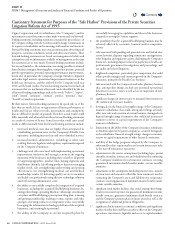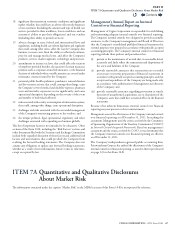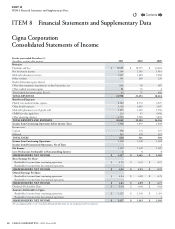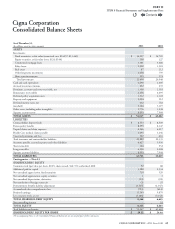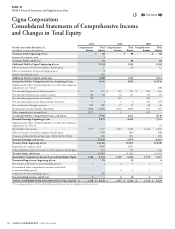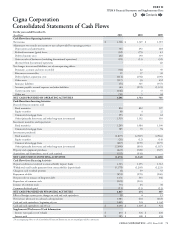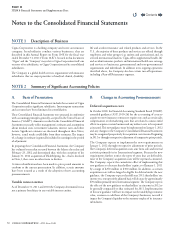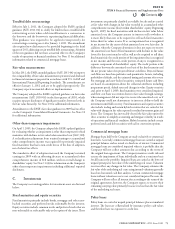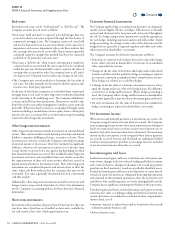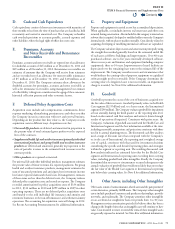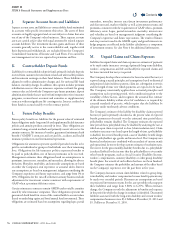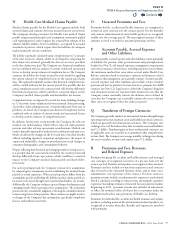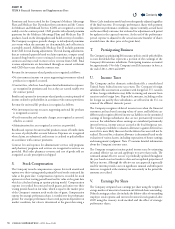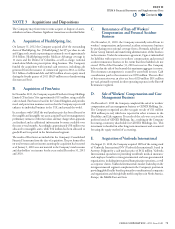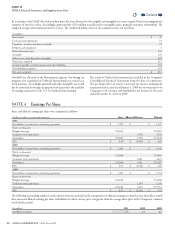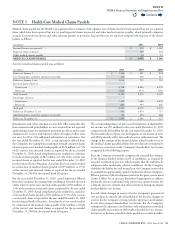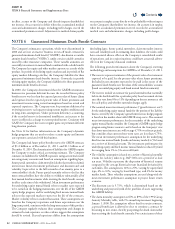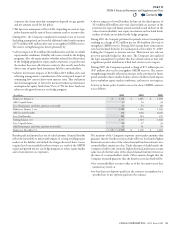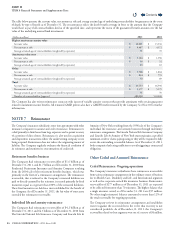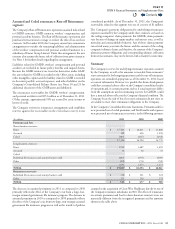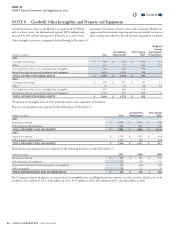Cigna 2011 Annual Report Download - page 98
Download and view the complete annual report
Please find page 98 of the 2011 Cigna annual report below. You can navigate through the pages in the report by either clicking on the pages listed below, or by using the keyword search tool below to find specific information within the annual report.
76 CIGNA CORPORATION2011 Form10K
PART II
ITEM 8 Financial Statements and Supplementary Data
J. Separate Account Assets and Liabilities
Separate account assets and liabilities are contractholder funds maintained
in accounts with specic investment objectives. e assets of these
accounts are legally segregated and are not subject to claims that arise
out of any of the Company’s other businesses. ese separate account
assets are carried at fair value with equal amounts for related separate
account liabilities. e investment income, gains and losses of these
accounts generally accrue to the contractholders and, together with
their deposits and withdrawals, are excluded from the Company’s
Consolidated Statements of Income and Cash Flows. Fees earned for
asset management services are reported in premiums and fees.
K. Contractholder Deposit Funds
Liabilities for contractholder deposit funds primarily include deposits
received from customers for investment-related and universal life products
and investment earnings on their fund balances. ese liabilities are
adjusted to reect administrative charges and, for universal life fund
balances, mortality charges. In addition, this caption includes premium
stabilization reserves that are insurance experience refunds for group
contracts that are left with the Company to pay future premiums, deposit
administration funds that are used to fund nonpension retiree insurance
programs, retained asset accounts and annuities or supplementary
contracts without signicant life contingencies. Interest credited on
these funds is accrued ratably over the contract period.
L. Future Policy Benefits
Future policy benets are liabilities for the present value of estimated
future obligations under long-term life and supplemental health insurance
policies and annuity products currently in force. ese obligations are
estimated using actuarial methods and primarily consist of reserves for
annuity contracts, life insurance benets, guaranteed minimum death
benet (“GMDB”) contracts and certain life, accident and health
insurance products in our International operations.
Obligations for annuities represent specied periodic benets to be
paid to an individual or groups of individuals over their remaining
lives. Obligations for life insurance policies represent benets to
be paid to policyholders, net of future premiums to be received.
Management estimates these obligations based on assumptions as to
premiums, interest rates, mortality and surrenders, allowing for adverse
deviation. Mortality, morbidity, and surrender assumptions are based
on either the Company’s own experience or actuarial tables. Interest
rate assumptions are based on management’s judgment considering the
Company’s experience and future expectations, and range from 1% to
10%. Obligations for the run-o settlement annuity business include
adjustments for investment returns consistent with requirements of
GAAP when a premium deciency exists.
Certain reinsurance contracts contain GMDB under variable annuities
issued by other insurance companies. ese obligations represent the
guaranteed death benet in excess of the contractholder’s account values
(based on underlying equity and bond mutual fund investments). ese
obligations are estimated based on assumptions regarding lapse, partial
surrenders, mortality, interest rates (mean investment performance
and discount rate), market volatility as well as investment returns and
premiums, consistent with the requirements of GAAP when a premium
deciency exists. Lapse, partial surrenders, mortality, interest rates
and volatility are based on management’s judgment considering the
Company’s experience and future expectations. e results of futures
and swap contracts used in the GMDB equity and growth interest rate
hedge programs are reected in the liability calculation as a component
of investment returns. See also Note6 for additional information.
M. Unpaid Claims and Claims Expenses
Liabilities for unpaid claims and claim expenses are estimates of payments
to be made under insurance coverages (primarily long-term disability,
workers’ compensation and life and health) for reported claims and
for losses incurred but not yet reported.
e Company develops these estimates for losses incurred but not yet
reported using actuarial principles and assumptions based on historical
and projected claim incidence patterns, claim size, subrogation recoveries
and the length of time over which payments are expected to be made.
e Company consistently applies these actuarial principles and
assumptions each reporting period, with consideration given to the
variability of these factors, and recognizes the actuarial best estimate
of the ultimate liability within a level of condence, as required by
actuarial standards of practice, which require that the liabilities be
adequate under moderately adverse conditions.
e Company’s estimate of the liability for disability claims reported
but not yet paid is primarily calculated as the present value of expected
benet payments to be made over the estimated time period that a
policyholder remains disabled. e Company estimates the expected
time period that a policyholder may be disabled by analyzing the rate at
which an open claim is expected to close (claim resolution rate). Claim
resolution rates may vary based upon the length of time a policyholder
is disabled, the covered benet period, cause of disability, benet design
and the policyholder’s age, gender and income level. e Company uses
historical resolution rates combined with an analysis of current trends
and operational factors to develop current estimates of resolution rates.
e reserve for the gross monthly disability benets due to a policyholder
is reduced (oset) by the income that the policyholder receives under
other benet programs, such as Social Security Disability Income,
workers’ compensation, statutory disability or other group disability
benet plans. For awards of such osets that have not been nalized,
the Company estimates the probability and amount of the oset based
on the Company’s experience over the past three to ve years.
e Company discounts certain claim liabilities related to group long-
term disability and workers’ compensation because benet payments may
be made over extended periods. Discount rate assumptions are based
on projected investment returns for the asset portfolios that support
these liabilities and range from 3.80% to 6.25%. When estimates
change, the Company records the adjustment in benets and expenses
in the period in which the change in estimate is identied. Discounted
liabilities associated with the long-term disability and certain workers’
compensation businesses were $3.2billion at December31,2011 and
$3.1 billion at December31,2010.
Contents
Q


